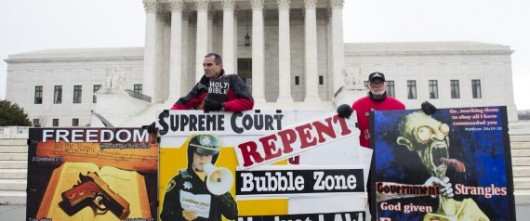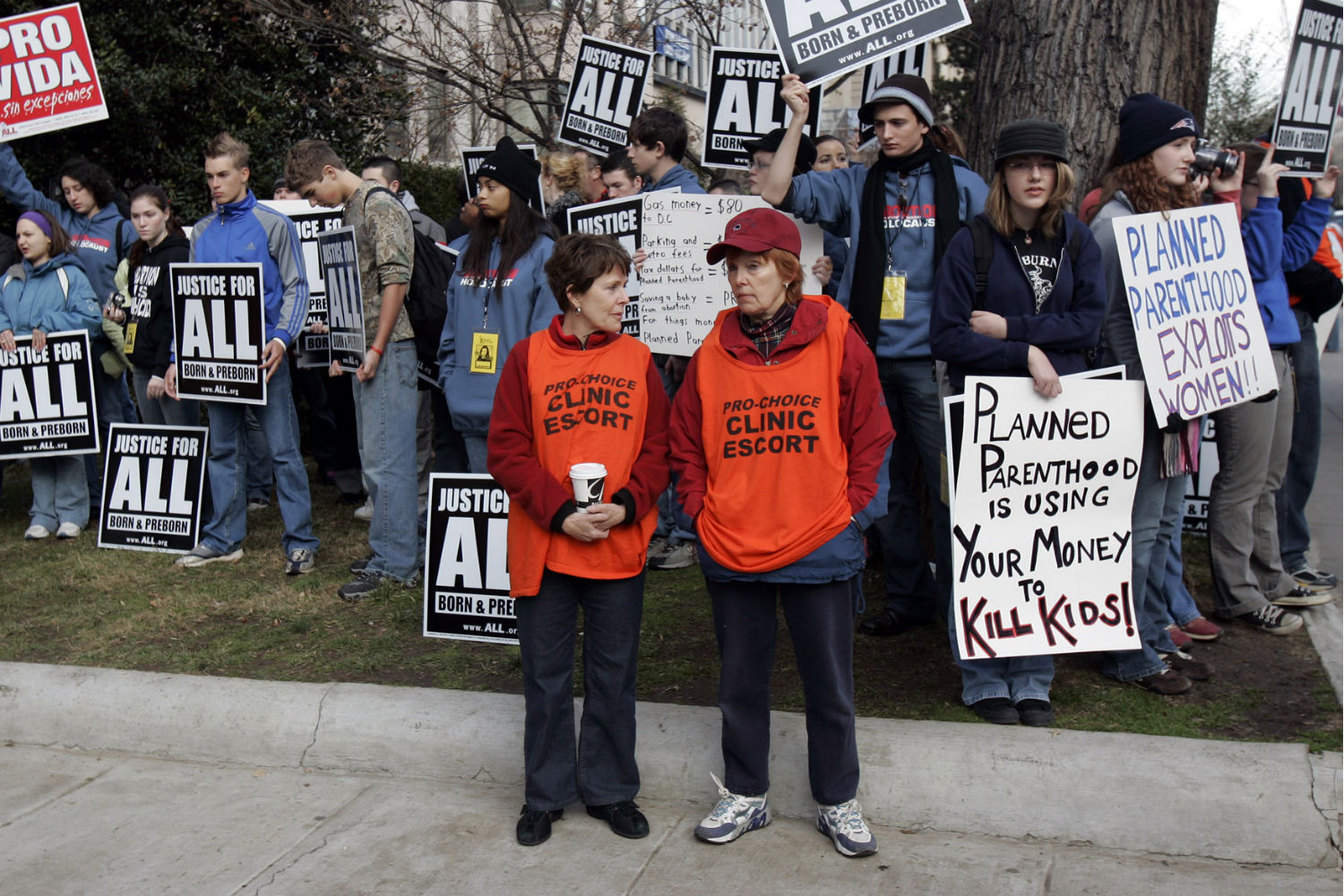Pitting one constitutional right against another is never easy, and it is particularly difficult when one of the rights at issue is the politically and emotionally charged issue of abortion rights.
At the end of June, the Supreme Court struck down a Massachusetts law establishing a 35 foot “buffer zone” around abortion clinics, enacted in response to a history of violence outside clinics. The buffer zone was designed to protect women seeking abortions from harassment by anti-abortion protesters who frequently gather outside clinics, but in McCullen v. Coakley, the Court held that the “buffer zones impose serious burdens on petitioners’ speech” because they “compromise [protesters’] ability to initiate the close, personal conversations that they view as essential to ‘sidewalk counseling.’”
The result is ironic, given that Supreme Court regulations prohibit “demonstrations, picketing, speechmaking, marching, holding vigils or religious services and all other like forms of conduct that involve the communication or expression of views or grievances, engaged in by one or more persons” on the main plaza in front of the Court.

Nonetheless, all nine justices voted to strike down the Massachusetts law. However, opinions about the case by First Amendment scholars are hardly unanimous. Indeed, the decision has come under more criticism from within the First Amendment community than almost any other in recent memory. The following is a sample of some of the different and conflicting views of the Court’s decision:
Stephen Shapiro, Legal Director of the ACLU
“We agree that a fixed buffer zone imposes serious First Amendment costs, but we also think the Court underestimated the proven difficulty of protecting the constitutional rights of women seeking abortions by enforcing other laws – especially regarding harassment – outside abortion clinics. Today’s opinion makes it more important than ever that the police enforce the laws that do exist in order to ensure that women and staff can safely enter and leave abortion clinics.” (ACLU)
Richard Posner, Judge, United States Seventh Circuit Court of Appeals
“Lecturing strangers on a sidewalk is not a means by which information and opinion are disseminated in our society. Strangers don’t meet on the sidewalk to discuss ‘the issues of the day.’ (Has Chief Justice John Roberts, the author of the opinion, ever done such a thing?). The assertion that abortion protesters ‘wish to converse’ with women outside an abortion clinic is naive. They wish to prevent the women from entering the clinic, whether by showing them gruesome photos of aborted fetuses or calling down the wrath of God on them. This is harassment of people who are in a very uncomfortable position; the last thing a woman about to have an abortion needs is to be screamed at by the godly.” (Slate)
Laurence Tribe, Professor of Constitutional Law at Harvard Law School
“In his quest to bring all his colleagues on board, Chief Justice Roberts wrote an opinion that implausibly described the Massachusetts statute as neutral as between anti-abortion speech and abortion rights speech — a neutrality that four conservative justices rightly dismissed as illusory, revealing a court sharply divided beneath its veneer of unanimity. . . [N]either empathy for their anguish, nor the need to protect the safety of women seeking such services, nor the clear need to guard against the rising tide of state laws designed to restrict access to abortions, can justify far-reaching measures that restrict peaceful conversation in public spaces.” (New York Times)
Hadley Arkes, Professor of Jurisprudence at Amherst College
“For my own part, I think that Justice Scalia is inescapably right in seeing the statute in Massachusetts as part of a scheme to close down, in the public forum, speech that is critical of abortion. But that critique may distract us from seeing what has been accomplished in this case. John Roberts, in his opinion for the majority, has picked up on some of the critical points that Scalia himself made during the oral argument in McCullen v. Coakley — most notably, that it was quite wrong to describe the speech of Eleanor McCullen as a “protest.” For Roberts it was as critical here, as it has been for Scalia, to put the accent on the fact that Eleanor McCullen works by quietly offering information to women entering an abortion clinic.” (National Review)
Geoffrey Stone, Professor of Law at the University of Chicago Law School
“Critics of the decision regard [the plurality’s] approach as fundamentally naïve and unrealistic about what actually happens when anti-abortion protesters gather near the entrances to these facilities. These critics maintain that the image of the grandmotherly woman calmly approaching a young woman heading into the clinic in order to have an abortion and asking her if they might chat a bit about whether this is really a good idea is wholly fanciful and blinks the reality of what actually happens at these moments. . . . [I]t is worth noting that this case must have been especially difficult for the Court’s four ‘liberals,’ all of whom are strong protectors of both the freedom of speech and the right of a woman to terminate an unwanted pregnancy. For them, Justice Roberts’ moderate, middle-ground probably gave them a resolution that, although perhaps not ideal, they could live with.” (Huffington Post)
Dahlia Lithwick, Senior Editor at Slate
“[It’s] exhausting to keep hearing from the pro-life movement that women seeking abortions are magical pixie princesses, who must be — thank you Justice Kennedy — babied and soothed and gently counseled for the brief moments in which they contemplate abortion. As though these “difficult conversations” are really only for their own benefit. Unlike mourners, or voters, or Supreme Court justices, they simply need to be told what to do. That’s why this case is harder than a simple “yay, speech wins” reaction can capture: Privileging “gentle counseling” for some isn’t quite the same as promoting free speech for all.” (Slate)
NCAC thanks Ron Collins, a legal scholar on First Amendment issues, who collected these reactions to the decision from First Amendment scholars and allowed us to reprint. You can read all nine reactions on his FAN 20.4 (First Amendment News) column at ConcurringOpinions.com.


